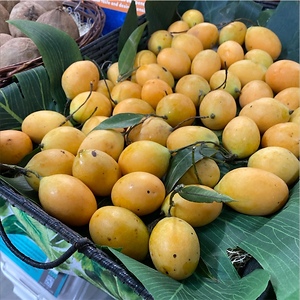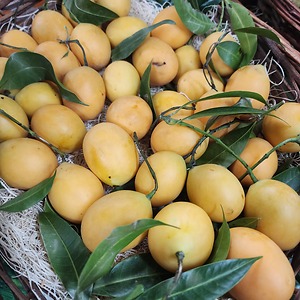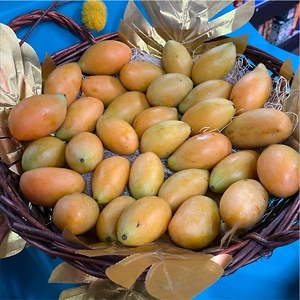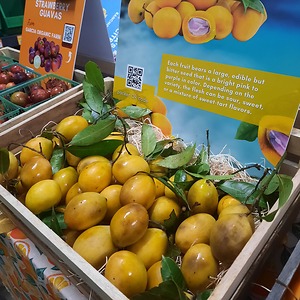


Maprang Mangoes
Estimated Inventory, lb : 0
This item was last sold on : 04/19/24
Description/Taste
Maprang is small, averaging 2 to 5 centimeters in diameter and 3 to 7 centimeters in length, and has an oval, egg-like shape with one blunt, curved end and a slightly tapered tip on the stem end. The skin is thick, taut, and firm, with a velvety, smooth feel. The surface ripens from green to dusty shades of golden yellow-orange, and some fruits may bear a light green tinge surrounding the stem. The skin is challenging to peel from the flesh and has a chewy, slightly toothsome nature. Underneath the exterior, the yellow-orange flesh encases a large central seed. This seed is said to be edible and showcases a bright pink to purple interior, but it has a very astringent, fibrous, and bitter taste. When opened, the flesh is soft, tender, aqueous, and glistening, and fibers extend from the seed into the flesh, tightly adhering in the center. Maprang is edible raw and can be eaten in its young green state and mature stages. The fruits release a subtly sweet, fruity, and tropical taste with turpentine nuances when opened, and the flesh has a sweet, acidic, tart, and tangy flavor, depending on the variety.
Seasons/Availability
Maprang is harvested at varying times, depending on the region and climate. The fruits are generally available from February to June. Regardless of the area, the overall availability of the fruits is short, only lasting a few weeks.
Current Facts
Maprang, botanically classified as Bouea macrophylla, is a tropical species belonging to the Anacardiaceae family. The small fruits are thought to be native to forests of Southeast Asia and grow on evergreen trees reaching 25 meters in height. Maprang trees begin bearing fruit approximately 8 to 10 years when planted from seed and 2 to 3 years when grafted, and each tree can produce up to 200 kilograms of fruit per season. Maprang grows in dangling clusters of 1 to 15 fruits and is harvested when ripe. The fruits are foraged from wild trees, grown in home gardens, and are commercially produced on a small scale. Maprang has a short season and is prominently stacked in large, vibrant piles through local vendors in Asian markets as a fresh-eating and culinary fruit. Outside of Asia, the species is a specialty fruit only grown in limited quantities. Maprang is a moniker derived from Thailand and is also known in the country as Mayong, Bak Prang, Prang, Somprang, and Maphang. In the Philippines, the fruits are called Gandria; in Vietnam, they are known as Thanh Tra; and in Indonesia, they have several regional names, including Ramania, Barania, Luber, Remie, Po Pandaria, Gandoriah, Kendara, and Wetes. Maprang is also common in Malaysia under the names Buah Kungang, Kundang, Asam Suku, Konodongan, Rembunia, Rumia, and Rumenia, and in English, the species is identified as Mango Plum, Marian Plum, Egg Plum, and Plum Mango. Several varieties of Maprang are generally categorized in markets, and the fruits can be divided into sweeter and sour types. When in season, Maprang is a versatile ingredient, consumed in its early or mature stages, and the fruits are favored for their sweet and acidic flavor in a wide array of culinary preparations.
Nutritional Value
Maprang is a source of vitamin C to strengthen the immune system, fiber to regulate the digestive tract, and calcium to protect bones and teeth. The fruits also provide phosphorus to repair tissues, iron to develop the protein hemoglobin for oxygen transport through the bloodstream, beta-carotene, which is converted into vitamin A in the body to maintain healthy organs, and other nutrients, including magnesium, niacin, thiamine, and riboflavin.
Applications
Maprang has a sweet, acidic, and tangy taste suited for fresh and cooked preparations. The fruits can be consumed in their young green stage or mature yellow-orange stage and are entirely edible, including the skin and seed. It is up to the consumer's discretion to eat the seed, as it typically has a bitter and astringent flavor. Most consumers discard the seed. Young and green Maprang mangoes have a firm, crunchy nature and are sliced and eaten raw with a sprinkling of sugar, salt, or chili powder. The young fruits can also be shredded or chopped into rojak, also known as rujak, a crunchy salad and condiment popular in Southeast Asia. Green Maprang fruits can be cooked into curries and offer a sour note to create a more complex flavoring. They can also be pickled or incorporated into sambals. Ripe Maprang fruits have a softer texture and a sweeter taste. The fruits can be eaten out of hand, and the skin can be consumed or sliced from the flesh, depending on preference. Mature Maprang is often dipped into shrimp paste or a sweet fish sauce as a snack, or pieces of the fruit can be cut away. It is important to note that the seed is firmly embedded in the flesh and is challenging to remove. Maprang fruits can be simmered into syrups, jams, compotes, and jellies or infused into fillings for various sauces and desserts. The fruits can also be pressed into juices, smoothies, and shakes. In addition to the fruits, the young leaves are utilized in salads or mixed with chiles and shrimp paste as a flavorful dish. Maprang pairs well with aromatics such as garlic, ginger, onions, and chile peppers, fruits including pineapple, apple, papaya, mangosteen, coconut, and citrus, cucumbers, lettuce, and peanuts. Whole, unwashed Maprang mangoes will keep for 1 to 2 weeks when stored in a container in the refrigerator.
Ethnic/Cultural Info
Maprang is notably used in a traditional afternoon dish served during the hot season in Thailand. Som chun is a delicacy comprised of seasonal fruits topped over granita with a blend of savory aromatics. The dish uses fruits such as Maprang, lychee, bilimbi, citrus, or star gooseberries and combines these sweet and sour fruits with coconut flakes, crushed peanuts, ginger, and onions. Historically, the name som chum was derived from the aroma of pickled lychees used in the recipe. “Som” means “sour,” and “chun” means pungent. The dish is prized for its complex flavoring and blend of salty, sweet, and sour flavors. The recipe is consumed as a refreshing reprieve on hot days and is often nicknamed a customary treat served during Thailand’s version of afternoon tea. Beyond the fruits in Southeast Asia, the wood from Maprang trees is sometimes utilized as a construction material. Wood is used to make dagger sheaths, floorboards, and furniture.
Geography/History
Maprang, or Bouea macrophylla, is believed to be native to Southeast Asia and has been growing wild since ancient times. The exact origins of the species are unknown, as it is thought to have appeared in multiple sites throughout Southeast Asia. Maprang is a primarily tropical to subtropical species found in forests. Over time, the species was collected from wild sources and was selectively bred to create improved varieties for commercial production and home gardening. Cultivation contributed to the species’ expansion throughout Southeast Asia and eventually introduced it to tropical and subtropical regions worldwide. Today, Maprang is still wild throughout Southeast Asia and commercially cultivated in Thailand, Malaysia, Laos, and Indonesia. The trees are also planted in gardens as an ornamental and culinary species. Outside of Asia, Maprang is rare and grows in small quantities, including in areas of the Americas, Europe, and Australia.
Recipe Ideas
Recipes that include Maprang Mangoes. One
| Cooking With Nart |
|
PLUM MANGO KALE SMOOTHIE |
| Davina Da Vegan |
|
Nyonya Rojak |











